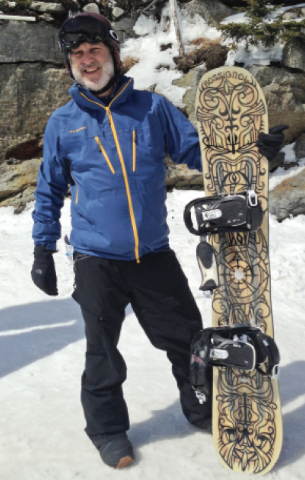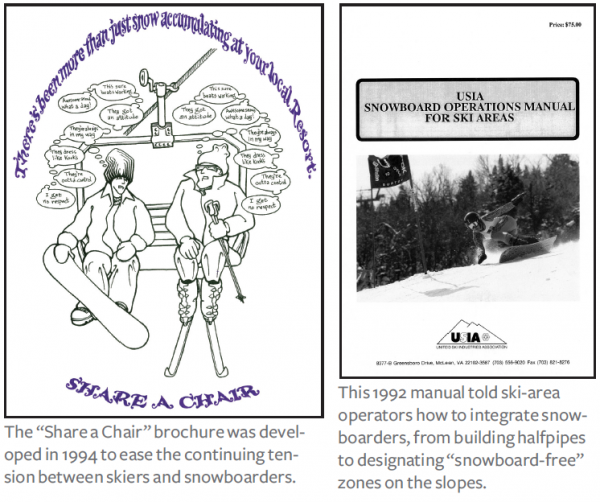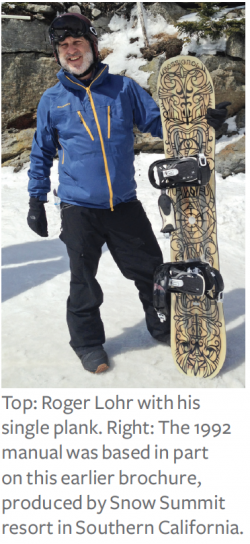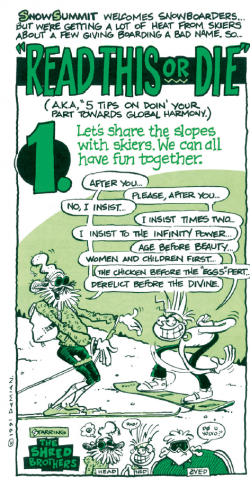
The man who wrote the manual recalls early efforts to bridge the cultural divide between skiers and snowboarders. By Roger Lohr
In the early 1990s, snowboarding was booming at mountain resorts across America, and skiers were not shy about voicing their disdain. Skiers mostly saw riders as reckless young upstarts—wise-assed, foul-mouthed kids who were crossing the fall line, pushing snow off the slopes, and ignoring the vaunted “Skier’s Code of Ethics.” They were poachers in paradise.

At the time, I was working for the United Ski Industries Association (USIA), a three-year trial marriage of the National Ski Areas Association (NSAA) and Ski Industries America (SIA). I was named liaison to the newly created USIA Snowboard Committee. The committee comprised Jake Burton, Brian Sellstrom of Trans-
World Snowboarding magazine, Brett Conrad of Wave Rave and Lee Rogers of Snow Summit, who was replaced by John Rice of Bear Mountain in California, where the Outlaw Snowboard Park was the first area with jumps and jibs.
Skiers were hating snowboarder antics on the slopes and the committee felt it should address this “situation.” At the time I was a telemark skier, which qualified me as a member of the lunatic fringe, so the decision-makers at USIA felt I was a good fit to work with the snowboarders. It wasn’t long before peer pressure required me to hang up the tele boards and become a “one plank wanker.” It took me about three seasons to master the snowboard…and on powder days, I’m particularly grateful that I did.
The committee’s concept was for me to research and produce a guidebook for ski area operators. The book would inform them about how to accept snowboarders (and their money) while de-escalating the simmering war on the slopes. The concept became a 15-chapter manual covering the essentials, including snowboard rental operations, etiquette, designating snowboard-free areas, tracking, marketing, instruction, and building halfpipes and parks. I tried to find examples of best practices at the few ski areas around the country known for embracing snowboarders.
 Resort operators had some trepidation about the manual, titled the USIA Snowboard Operations Manual for Ski Areas. I was informed that the association attorney would have to review the well-researched manifesto. He decided that for legal purposes the concept of snowboarding would hereto be termed “snowboard skiing” on every page of the publication. He also renamed the chapter titled “Conflict Mitigation,” which covered how areas could address snowboard attitudes and antics as well as skier prejudice, to “Harmony Through Education.” This chapter provided ideas such as proactive education, snowboard ambassadors, and the ultimate “red slip” warning—clipping tickets to throw the bums out. Some of the information was based on the Snow Summit brochure Read This or Die: Tips on Doin’ Your Part Towards Global Harmony. I was so proud of the manual, which was published in 1992, that I dedicated it to my mother, my wife and my son.
Resort operators had some trepidation about the manual, titled the USIA Snowboard Operations Manual for Ski Areas. I was informed that the association attorney would have to review the well-researched manifesto. He decided that for legal purposes the concept of snowboarding would hereto be termed “snowboard skiing” on every page of the publication. He also renamed the chapter titled “Conflict Mitigation,” which covered how areas could address snowboard attitudes and antics as well as skier prejudice, to “Harmony Through Education.” This chapter provided ideas such as proactive education, snowboard ambassadors, and the ultimate “red slip” warning—clipping tickets to throw the bums out. Some of the information was based on the Snow Summit brochure Read This or Die: Tips on Doin’ Your Part Towards Global Harmony. I was so proud of the manual, which was published in 1992, that I dedicated it to my mother, my wife and my son.
The second iteration of the Snowboard Committee was launched after USIA dissolved back into separate associations, SIA and NSAA. The snowboard product suppliers were becoming increasingly plentiful and important to SIA, and they were gobbling up space at the annual trade show. The SIA Snowboard Committee was expanded to more than a dozen members and Brad Steward (Bonfire, Salomon) took over the committee reins.
The “Share a Chair” brochure was developed in 1994 to relieve the continued tension on the slopes between skiers and ri

ders. Dennis Jenson, the marketing guru at Burton, translated the Skier’s Code into “snowboard-ese” and made it hipper. Steward enlisted art director Ross Wordhouse to design the brochure and the committee developed tag lines like “There’s been more than just snow accumulating at your local resort” and “Things we all have in common.” Some of the “Important Things to Consider” included “destructive and offensive behavior is totally lame.”
The brochure was a masterpiece and upon receiving the mock-up, I contacted Wordhouse to inquire about the neat font he had used for the copy. He replied, “Font? I printed it by hand!” Color me impressed. We printed 250,000 copies and shipped them off to ski areas across the nation.
Later, when Steward served on the SIA Board of Directors, we chatted about the difficult days of assimilating snowboarders. He said: “I once spoke with an older lady who was sitting at a resort lodge, looking up at a slope filled with skiers and snowboarders. ‘It’s so nice to see all these skiers having fun,’” she said. “Everyone just got used to each other.”
Roger Lohr worked at SIA from 1986 to 1998 and then as a snowsports project manager, writer and promoter. He is the cross-country ski editor for SnoCountry.com and SeniorsSkiing.com
